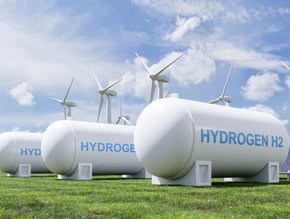Taking the lid off digital transformation

Amish Sabharwal is Executive Vice President for AVEVA’s Industrial Engineering Business Unit which is responsible for delivering simulation, engineering, design, project execution, operator training and project management software to the Global Industrial Market. With 25 years' experience globally within the Energy, Chemicals and Power industries, he is focused on delivering Digital Transformation outcomes for Owner Operators, EPC and Suppliers by leveraging technology to create value added opportunities to business processes. Amish is a professional engineer who holds a Masters and Bachelors in Chemical Engineering from the University of Calgary. Here he reflects on the impact the pandemic has had on the industry and why it must be at the cutting edge of digital transformation.
Oil and gas companies faced formidable challenges to their efficiency, sustainability and profitability in 2020. As a result of the pandemic, prices collapsed severely and the urgency to tackle these issues intensified. The economic discomfort is being felt throughout the oil and gas value chain.
Upstream companies seek to maximise production from onshore and offshore wells safely and economically. In the midstream, the primary concern of hydrocarbon pipeline operators is to ensure safe, reliable and compliant operations - all while managing energy costs and minimising time and installed costs. Across the downstream, refining and petrochemical producers strive to achieve superior performance through better management of their energy usage and costs.
Considering these priorities, the lack of digital maturity across oil and gas is perhaps surprising. According to multinational professional services firm PwC, “One of the clearest and most viable responses to these systemic challenges is to accelerate digitisation strategies to help improve resilience and remain attractive to investors.” But, “of more than 200 oil and gas companies surveyed, only 7% identified themselves as digital champions while more than 70% of respondents considered themselves to be in the early stages of digital maturity”.
Optimisation and innovation
In today’s economic environment, capital budgets and overheads are constantly being cut. Oil and gas producers are faced with rising manufacturing costs, global competition and soaring energy costs. To meet these challenges, companies must optimise manufacturing operations and make performance improvements to positively impact their bottom lines.
Digital transformation offers new toolsets that enable oil and gas producers to increase their competitiveness. These digital toolsets help improve yields of valuable products while reducing energy consumption and increasing throughput. Using digital technology, manufacturers can create a complete digital twin of their processes and assets to respond quickly and easily to unexpected events, reduce shutdown time, work and train operators remotely and evaluate what-if scenarios in batch processing and manufacturing.
Through digital transformation, operators can combine real-time process data with current economic conditions, giving operators the ability to make informed decisions at an expedited rate. Information sharing increases while stakeholders also improve their ability to visualise results and key performance indicator data across processes and overall plant production.
Technology offers the potential to impact process yield, energy use and throughput optimisation. Here are some considerations:
Own and maintain your own engineering data
Engineering data tells you what equipment is installed on each plant, what size it is, how it is connected and where it is located through 3D visualisation. It is generated in capital projects, from newbuild plants to brownfield revamps, and forms the backbone of the digital twin.
Accurate data, kept in one place, ensures the reliability of a digital twin’s output and the efficiency of operations throughout the asset’s lifecycle. Global oil and gas producers are moving fast to invest in their own cloud-based data platforms for current and future capital projects, operations and maintenance as part of their digital transformation projects.
Evaluate process design in the cloud to reduce costs
By leveraging the almost infinite processing power and storage available through cloud-based architecture, companies can accelerate process design while reducing capital investment costs for process modelling and training.
Oil and gas producers can spin up cloud-based servers and computing resources as needed. This also accelerates the flow of information throughout process design. A cloud-based architecture for process design increases information accessibility, enhances availability and significantly reduces total cost of ownership.
Encourage online collaboration
Process innovations becomes seamless through collaboration. Separating the content from the product allows the content, such as simulation models, to be managed easily with file history logs in a central repository. Efficiency is significantly increased using cloud-based architecture as refineries can adapt to changing needs.
Computing power can also be scaled up or down with varying numbers of virtual machines to facilitate simulation templates for engineering test or training scenarios. Secure user access control allows administrators to add, delete or edit users and privileges as needed. IT overheads are simplified to a pure on-demand cloud-based architecture where machines are accessed via a secure URL, and new versions of process designs are available as soon as released.
Accelerate operational excellence through a digital engineering platform
Consider supporting the entire engineering lifecycle from representation of the actual piping and instrumentation diagram, mapping each equipment object to a detailed engineering database and 3D model; to building/testing the dynamic stimulation early in the process design; optimising the process and control design, comparing capital versus operating costs; and the continuous improvement of operations as the engineering model becomes a plant’s digital twin.
Unify your supply chain model planning and operations
A complete 360-degree view of the digital value chain means all aspects of the enterprise are visualised, analysed and optimised. Inputs to the enterprise, such as feedstock and raw materials, are analysed in real-time against planning, operations, scheduling and distribution. Full plant models are managed simultaneously within a supply and distribution network.
Combining data and analysis
There are three key technological trends that will continue to accelerate adoption and help businesses reinvent themselves. First, cloud computing allows companies to manage large volumes of data generated in operations and improves data quality, data availability and single-source transparency across complex value chains.
Second, connectivity and the Internet of Things, in which machines carry sensors that support remote performance monitoring and efficient equipment integration, will support energy use optimisation and costs across company operations. Third, AI and ML tools help analyse data and identify operational patterns and shortcomings that can be used to improve efficiency, for example, in predictive maintenance.
Digital transformation offers a fresh lens to improve workforce training, sustainability, productivity, safety and regulatory compliance - while adapting to unforeseen events. Through digital transformation, oil and gas producers can more confidently explore opportunities, reduce operational risk and shrink the gap between plans and results.
- Tan Delta Technology Empowers the Sustainable Energy SectorRenewable Energy
- Debunking Silicon Carbide (SiC) Myths: The Real StoryTechnology & AI
- Terabase raises US$25m for energy project construction techTechnology & AI
- How can businesses reap the benefits of mobile technology?Technology & AI






